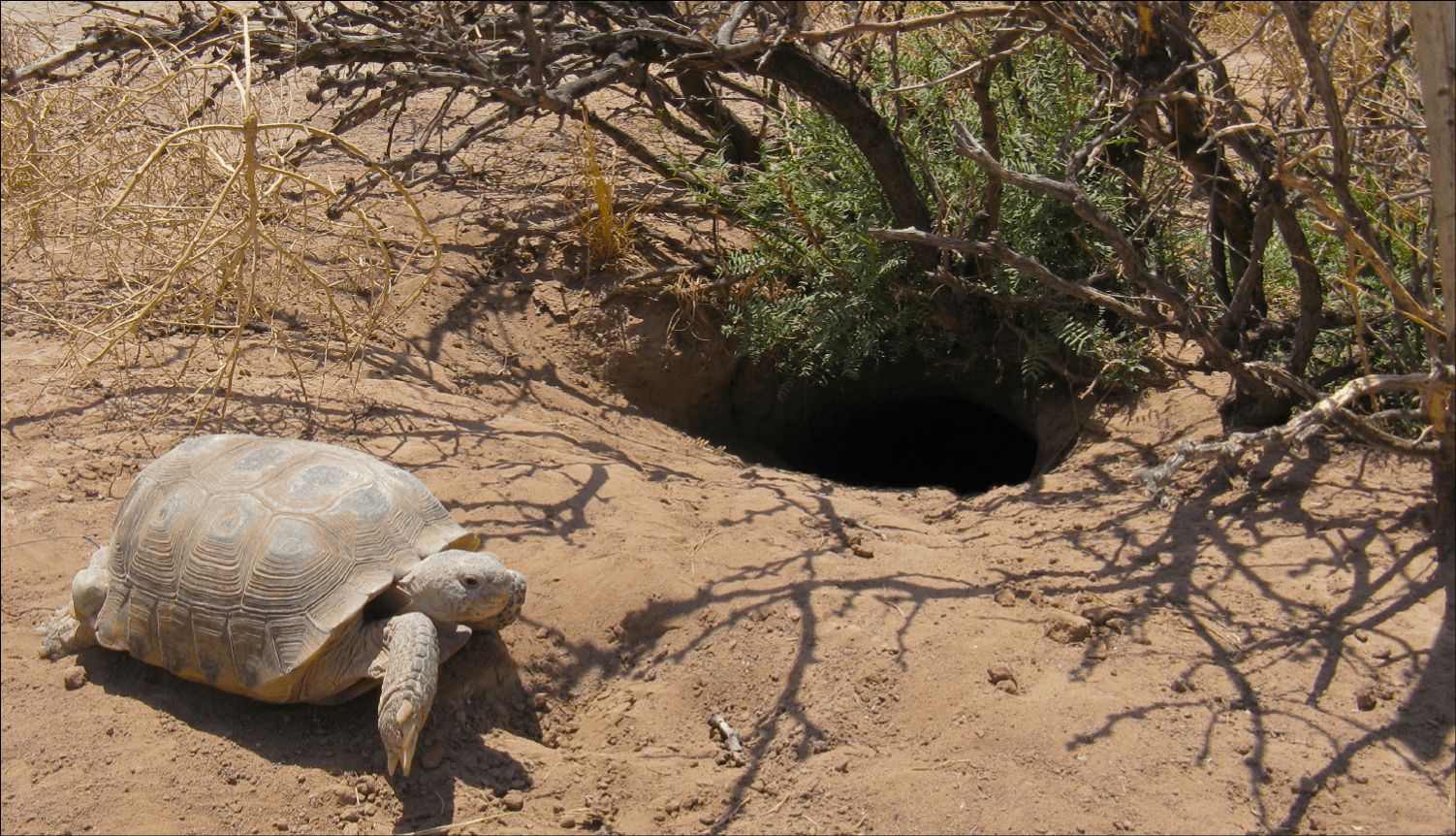
Species
Bolson tortoise (Gopherus flavomarginatus)
Principal Biologist(s)
Chris Wiese, Scott Hillard
Project Location
Armendaris Ranch, NM
Ladder Ranch, NM
Project Partners
Living Desert Zoo and Gardens State Park in Carlsbad, NM (LDZG)
El Paso Zoo, El Paso, TX
San Antonio Zoo, San Antonio, TX
Turtle Conservancy
Dr. Jim Jarchow, DVM, Tucson, AZ
Dr. Vicky Milne, DVM, El Paso Zoo, TX
Dr. Peter Koplos, DVM, El Paso, TX
Dr. Taylor Edwards, University of Arizona
The Appleton Family
Conservation Problem
Population decline and contraction of the bolson tortoise range is due to climate change; habitat fragmentation, degradation and loss; and collection for food. Recent estimates suggest that fewer than 2,000 bolson tortoises remain in the wild. Our bolson tortoise recovery efforts have produced ~500 new bolson tortoises to date, thus contributing a significant boost to worldwide bolson tortoise numbers.
Conservation Status
• Listed as Endangered under the ESA
• Listed as Endangered under Mexican Wildlife Law
• IUCN Red List Status: Critically Endangered
Project Goals
Our overall goal is to establish independent, free-living, minimally managed bolson tortoise populations in the northern portion of the Chihuahuan Desert, which constitutes their prehistoric range. To this end, we aim to increase bolson tortoise population size through robust captive breeding and head-start programs that protect juveniles until they reach a predator-resistant size. We also aim to release juvenile bolson tortoises on the Ladder and Armendaris Ranches to establish wild populations.
Objectives
Captive population objective: During the next 20 years, we will use captive breeding to produce juveniles to build a large captive population of bolson tortoises.
Wild Population objective: We will use the captive population to establish up to four wild bolson tortoise colonies on suitable private and/or public lands in the U.S. Each colony will have at least 250 adults and exhibit a male to female ratio of around 1:1, stable or positive population growth, and evidence of reproduction.
Project Background
The largest and rarest of the five North American tortoise species, the bolson tortoise is thought to have once lived throughout most of the Chihuahuan desert, but its current range is restricted to a small area in north central Mexico where the states of Durango, Chihuahua, and Coahuila meet. Due to a suite of political, social, economic, and personal safety issues, the current status of the bolson tortoise in the wild is largely unknown. The last population survey estimated fewer than 10,000 animals alive in the early 1980’s. However, continued habitat degradation and loss since then make it likely that this number has since decreased significantly. In an effort to prevent the extinction of the bolson tortoise, we are working towards establishing free-ranging bolson tortoise populations on the Ladder and Armendaris Ranches in New Mexico, which lie at the northern tip of the tortoise’s prehistoric range.
Our starting point for the northern Chihuahua bolson tortoise reintroduction project was a group of 30 bolson tortoises that were collected and bred over a period of nearly 40 years by a private individual from Arizona. Ms. Appleton’s collection was donated to TESF in 2006, and 26 adult (plus 7 hatchlings) tortoises were moved from Arizona to the Armendaris Ranch to serve as a captive breeding colony for our reintroduction program. Four tortoises (2 males, 2 females) were donated to the Living Desert Zoo and Gardens (LDZG, Carlsbad, New Mexico), where they are on exhibit. Successful breeding programs on the Armendaris and at the LDZG have hatched over 400 juvenile tortoises since 2006. Hatchlings and juveniles are being kept on native forage in outdoor, predator-proof enclosures until they are large enough to be released (about the size of the native box turtle or ~110 mm shell length). Tortoise growth rates depend both on the weather and on forage availability. It typically takes between 3 and 7 years or more for a hatchling bolson tortoise to reach 110 mm.
With their powerful front legs, tortoises dig burrows in which they spend over 85% of their time. The burrows are an important part of a healthy desert ecosystem, as they provide shelter for a myriad other species, including mammals, birds, reptiles, and insects.
Project Activities in 2018
Our captive bolson tortoise population has 28 adults that serve as the founders for all juveniles produced by the project. To date, we have produced over 840 hatchlings, and as of fall 2018, 537 of these juvenile tortoises were confirmed to be alive, 206 had died, and 66 were unaccounted for and their status unknown. During the period 2012-2018, 164 larger juveniles (shell length > 100 mm) have been equipped with transmitters and moved from predator-proof to predator-accessible enclosures. 118 (72%) of these transmitted juveniles were confirmed to be alive in 2018.
Future Activities and Considerations
Our major objectives for 2019 will be to:
• Continue building a robust captive population of tortoises as a source for wild releases
• Initiate releases of juvenile tortoises on the Armendaris so we can begin to build a strong, repatriated, minimally managed, wild population
• Continue to seek and collaborate with additional partners to expand the scope of the bolson tortoise project
• Continue our search for additional breeding adult tortoises to introduce additional genetic diversity into our breeding group
• Continue our efforts to obtain state and federal permits to release tortoises outside of enclosures on Turner lands
The methods we will employ to achieve these objectives include:
• Collecting the eggs of genetically underrepresented females and incubating them to ensure continued robust hatchling production while also planning to leave a large portion of the eggs to develop in natural nests
• Surveying the tortoise population at least once a year
• Increasing forage availability in headstart pens by harvesting plants from the environment
• Enhancing available forage
• Transferring juveniles to predator-accessible enclosures to free up space in the headstart pens
• Monitoring released juveniles to track survivorship and movements
